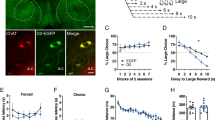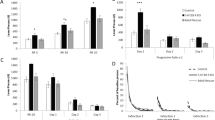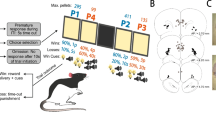Abstract
The thalamus and central dopamine signaling have been shown to play important roles in high-level cognitive processes including impulsivity. However, little is known about the role of dopamine receptors in the thalamus in decisional impulsivity. In the present study, rats were tested using a delay discounting task and divided into three groups: high impulsivity (HI), medium impulsivity (MI), and low impulsivity (LI). Subsequent in vivo voxel-based magnetic resonance imaging revealed that the HI rats displayed a markedly reduced density of gray matter in the lateral thalamus compared with the LI rats. In the MI rats, the dopamine D1 receptor antagonist SCH23390 or the D2 receptor antagonist eticlopride was microinjected into the lateral thalamus. SCH23390 significantly decreased their choice of a large, delayed reward and increased their omission of lever presses. In contrast, eticlopride increased the choice of a large, delayed reward but had no effect on the omissions. Together, our results indicate that the lateral thalamus is involved in decisional impulsivity, and dopamine D1 and D2 receptors in the lateral thalamus have distinct effects on decisional impulsive behaviors in rats. These results provide a new insight into the dopamine signaling in the lateral thalamus in decisional impulsivity.





Similar content being viewed by others
References
Dalley JW, Everitt BJ, Robbins TW. Impulsivity, compulsivity, and top-down cognitive control. Neuron 2011, 69: 680–694.
Dalley JW, Mar AC, Economidou D, Robbins TW. Neurobehavioral mechanisms of impulsivity: fronto-striatal systems and functional neurochemistry. Pharmacol Biochem Behav 2008, 90: 250–260.
Basar K, Sesia T, Groenewegen H, Steinbusch HW, Visser-Vandewalle V, Temel Y. Nucleus accumbens and impulsivity. Prog Neurobiol 2010, 92: 533–557.
Zhang J, Nombela C, Wolpe N, Barker RA, Rowe JB. Time on timing: Dissociating premature responding from interval sensitivity in Parkinson’s disease. Mov Disord 2016, 31: 1163–1172.
Ahn WY, Ramesh D, Moeller FG, Vassileva J. Utility of machine-learning approaches to identify behavioral markers for substance use disorders: impulsivity dimensions as predictors of current cocaine dependence. Front Psychiatry 2016, 7: 34.
Izci F, Fındıklı EK, Zincir S, Zincir SB, Koc MI. The differences in temperament-character traits, suicide attempts, impulsivity, and functionality levels of patients with bipolar disorder I and II. Neuropsychiatr Dis Treat 2016, 12: 177–184.
Ma CL, Sun X, Luo F, Li BM. Prefrontal cortical α2A-adrenoceptors and a possible primate model of attention deficit and hyperactivity disorder. Neurosci Bull 2015, 31: 227–234.
Li Y, Zuo Y, Yu P, Ping X, Cui C. Role of basolateral amygdala dopamine D2 receptors in impulsive choice in acute cocaine-treated rats. Behav Brain Res 2015, 287: 187–195.
Zuo Y, Wang X, Cui C, Luo F, Yu P, Wang X. Cocaine-induced impulsive choices are accompanied by impaired delay-dependent anticipatory activity in basolateral amygdala. J Cogn Neurosci 2012, 24: 196–211.
Butler EG, Horne MK, Rawson JA. Sensory characteristics of monkey thalamic and motor cortex neurons. J Physiol 1992, 445: 1–24.
Behrens TE, Johansen-Berg H, Woolrich MW, Smith SM, Wheeler-Kingshott CA, Boulby PA, et al. Non-invasive mapping of connections between human thalamus and cortex using diffusion imaging. Nat Neurosci 2003, 6: 750–757.
Alexander GE. Parallel organization of functionally segregated circuits linking basal ganglia and cortex. Ann Rev Neurosci 1986, 9: 357–381.
Shany UT, Lin N, Rosen HJ, Sollberger M, Miller BL, Rankin KP. Self-awareness in neurodegenerative disease relies on neural structures mediating reward-driven attention. Brain 2014, 137: 2368–2381.
de Bourbon-Teles J, Bentley P, Koshino S, Shah K, Dutta A, Malhotra P, et al. Thalamic control of human attention driven by memory and learning. Curr Biol 2014, 24: 993–999.
Vorobyev V, Kwon MS, Moe D, Parkkola R, Hämäläinen H. Risk-taking behavior in a computerized driving task: brain activation correlates of decision-making, outcome, and peer influence in male adolescents. PLoS One 2015, 10: e0129516.
Guillery RW, Sherman SM. Thalamic relay functions and their role in corticocortical communication: generalizations from the visual system. Neuron 2002, 33: 163–175.
Shaw P, Weingart D, Bonner T, Watson B, Park MT, Sharp W, et al. Defining the neuroanatomic basis of motor coordination in children and its relationship with symptoms of attention-deficit/hyperactivity disorder. Psychol Med 2016, 46: 2363–2373.
Wang Q, Chen C, Cai Y, Li S, Zhao X, Zheng L, et al. Dissociated neural substrates underlying impulsive choice and impulsive action. Neuroimage 2016, 134: 540–549.
Wong CW, Olafsson V, Plank M, Snider J, Halgren E, Poizner H, et al. Resting-state fMRI activity predicts unsupervised learning and memory in an immersive virtual reality environment. PLoS One 2014, 9: e109622.
Chakraborty S, Kolling N, Walton ME, Mitchell AS. Critical role for the mediodorsal thalamus in permitting rapid reward-guided updating in stochastic reward environments. Elife 2016, 5: e13588.
Miedl SF, Wiswede D, Marco-Pallarés J, Ye Z, Fehr T, Herrmann M, et al. The neural basis of impulsive discounting in pathological gamblers. Brain Imaging Behav 2015, 9: 887–898.
Amlung M, Sweet LH, Acker J, Brown CL, MacKillop J. Dissociable brain signatures of choice conflict and immediate reward preferences in alcohol use disorders. Addict Biol 2014, 19: 743–753.
van Gaalen MM, van Koten R, Schoffelmeer AN, Vanderschuren LJ. Critical involvement of dopaminergic neurotransmission in impulsive decision making. Biol Psychiatry 2006, 60: 66–73.
Koffarnus MN, Newman AH, Grundt P, Rice KC, Woods JH. Effects of selective dopaminergic compounds on a delay-discounting task. Behav Pharmacol 2011, 22: 300–311.
Loos M, Pattij T, Janssen MC, Counotte DS, Schoffelmeer AN, Smit AB, et al. Dopamine receptor D1/D5 gene expression in the medial prefrontal cortex predicts impulsive choice in rats. Cereb Cortex 2010, 20: 1064–1070.
Zeeb FD, Floresco SB, Winstanley CA. Contributions of the orbitofrontal cortex to impulsive choice: interactions with basal levels of impulsivity, dopamine signalling, and reward-related cues. Psychopharmacology (Berl) 2010, 211: 87–98.
Pezze MA, Dalley JW, Robbins TW. Differential roles of dopamine D1 and D2 receptors in the nucleus accumbens in attentional performance on the five-choice serial reaction time task. Neuropsychopharmacology 2007, 32: 273–283.
Besson M, Belin D, McNamara R, Theobald DE, Castel A, Beckett VL, et al. Dissociable control of impulsivity in rats by dopamine d2/3 receptors in the core and shell subregions of the nucleus accumbens. Neuropsychopharmacology 2010, 35: 560–569.
García-Cabezas MA, Martínez-Sánchez P, Sánchez-González MA, Garzón M, Cavada C. Dopamine innervation in the thalamus: monkey versus rat. Cereb Cortex 2009, 19: 424–434.
Savasta M, Dubois A, Scatton B. Autoradiographic localization of D1 dopamine receptors in the rat brain with [3H]SCH 23390. Brain Res 1986, 375: 291–301.
Dubois A, Savasta M, Curet O, Scatton B. Autoradiographic distribution of the D1 agonist [3H]SKF 38393, in the rat brain and spinal cord. Comparison with the distribution of D2 dopamine receptors. Neuroscience 1986, 19: 125–137.
Sun J, Xu J, Cairns NJ, Perlmutter JS, Mach RH. Dopamine D1, D2, D3 receptors, vesicular monoamine transporter type-2 (VMAT2) and dopamine transporter (DAT) densities in aged human brain. PLoS One 2012, 7: e49483.
Pifl C, Hornykiewicz O, Blesa J, Adánez R, Cavada C, Obeso JA. Reduced noradrenaline, but not dopamine and serotonin in motor thalamus of the MPTP primate: relation to severity of parkinsonism. J Neurochem 2013, 125: 657–662.
García-Cabezas MA, Rico B, Sánchez-González MA, Cavada C. Distribution of the dopamine innervation in the macaque and human thalamus. Neuroimage 2007, 34: 965–984.
Sánchez-González MA, García-Cabezas MA, Rico B, Cavada C. The primate thalamus is a key target for brain dopamine. J Neurosci 2005, 25: 6076–6083.
García-Cabezas MA, Martínez-Sánchez P, Sánchez-González MA, Garzón M, Cavada C. Dopamine innervation in the thalamus: monkey versus rat. Cereb Cortex 2009, 19: 424–434.
Young KA, Wilcox RE. Characterization of D2 receptors and dopamine levels in the thalamus of the rat. Life Sci 1991, 48: 1845–1852.
Winstanley CA, Zeeb FD, Bedard A, Fu K, Lai B, Steele C, et al. Dopaminergic modulation of the orbitofrontal cortex affects attention, motivation and impulsive responding in rats performing the five-choice serial reaction time task. Behav Brain Res 2010, 210: 263–272.
Fernando AB, Economidou D, Theobald DE, Zou MF, Newman AH, Spoelder M, et al. Modulation of high impulsivity and attentional performance in rats by selective direct and indirect dopaminergic and noradrenergic receptor agonists. Psychopharmacology (Berl) 2012, 219: 341–352.
Sled JG, Zijdenbos AP, Evans AC. A nonparametric method for automatic correction of intensity nonuniformity in MRI data. IEEE Trans Med Imaging 1998, 17: 87–97.
Ashburner J, Friston KJ. Voxel-based morphometry–the methods. Neuroimage 2000, 11: 805–821.
Ashburner J, Friston KJ. Unified segmentation. Neuroimage 2005, 26: 839–851.
Nie B, Chen K, Zhao S, Liu J, Gu X, Yao Q, et al. A rat brain MRI template with digital stereotaxic atlas of fine anatomical delineations in paxinos space and its automated application in voxel-wise analysis. Hum Brain Mapp 2013, 34: 1306–1318.
Pattij T, Schetters D, Schoffelmeer AN. Dopaminergic modulation of impulsive decision making in the rat insular cortex. Behav Brain Res 2014, 270: 118–124.
Mitrofanis J, Guillery RW. New views of the thalamic reticular nucleus in the adult and the developing brain. Trends Neurosci 1993, 16: 240–245.
Deng J, Elberger A. Corticothalamic and thalamocortical pathfinding in the mouse: Dependence on intermediate targets and guidance axis. Anat Embryol (Berl) 2003, 207: 177–192.
Ferrarelli F, Tononi G. The thalamic reticular nucleus and schizophrenia. Schizophr Bull 2011, 37: 306–315.
Pratt JA, Morris BJ. The thalamic reticular nucleus: a functional hub for thalamocortical network dysfunction in schizophrenia and a target for drug discovery. J Psychopharmacol 2015, 29: 127–137.
Price DD, Verne GN. Does the spinothalamic tract to ventroposterior lateral thalamus and somatosensory cortex have roles in both pain sensation and pain-related emotions? J Pain 2002, 3: 105–108.
Willis WD, Zhang X, Honda CN, Giesler GJ. Projections from the marginal zone and deep dorsal horn to the ventrobasal nuclei of the primate thalamus. Pain 2001, 92: 267–276.
Pagano RL, Fonoff ET, Dale CS, Ballester G, Teixeira MJ, Britto LR. Motor cortex stimulation inhibits thalamic sensory neurons and enhances activity of PAG neurons: possible pathways for antinociception. Pain 2012, 153: 2359–2369.
Lee S, Carvell GE, Simons DJ. Motor modulation of afferent somatosensory circuits. Nat Neurosci 2008, 11: 1430–1438.
Caprioli D, Sawiak SJ, Merlo E, Theobald DE, Spoelder M, Jupp B, et al. Gamma aminobutyric acidergic and neuronal structural markers in the nucleus accumbens core underlie trait-like impulsive behavior. Biol Psychiatry 2014, 75: 115–123.
Pardey MC, Kumar NN, Goodchild AK, Cornish JL. Catecholamine receptors differentially mediate impulsive choice in the medial prefrontal and orbitofrontal cortex. J Psychopharmacol 2013, 27: 203–212.
Wade TR, de Wit H, Richards JB. Effects of dopaminergic drugs on delayed reward as a measure of impulsive behavior in rats. Psychopharmacology (Berl) 2000, 150: 90–101.
Tian L, Qin X, Sun J, Li X, Wei L. Differential effects of co-administration of oxotremorine with SCH 23390 on impulsive choice in high-impulsive rats and low-impulsive rats. Pharmacol Biochem Behav 2016, 142: 56–63.
St Onge JR, Abhari H, Floresco SB. Dissociable contributions by prefrontal D1 and D2 receptors to risk-based decision making. J Neurosci 2011, 31: 8625–8633.
Schweimer J, Hauber W. Dopamine D1 receptors in the anterior cingulate cortex regulate effort-based decision making. Learn Mem 2006, 13: 777–782.
Beaulieu JM, Gainetdinov RR. The physiology signaling, and pharmacology of dopamine receptors. Pharmacol Rev 2011, 63: 182–217.
Govindaiah G, Wang T, Gillette MU, Crandall SR, Cox CL. Regulation of inhibitory synapses by presynaptic D4 dopamine receptors in thalamus. J Neurophysiol 2010, 104: 2757–2765.
De Mei C, Ramos M, Iitaka C, Borrelli E. Getting specialized: presynaptic and postsynaptic dopamine D2 receptors. Curr Opin Pharmacol 2009, 9: 53–58.
André MA, Manahan-Vaughan D. Involvement of dopamine D1/D5 and D2 receptors in context-dependent extinction learning and memory reinstatement. Front Behav Neurosci 2016, 9: 372.
Diaz E, Medellín J, Sánchez N, Vargas JP, López JC. Involvement of D1 and D2 dopamine receptor in the retrieval processes in latent inhibition. Psychopharmacology (Berl) 2015, 232: 4337–4346.
McAlonan K, Cavanaugh J, Wurtz RH. Attentional modulation of thalamic reticular neurons. J Neurosci 2006, 26: 4444–4450.
Halassa MM, Chen Z, Wimmer RD, Brunetti PM, Zhao S, Zikopoulos B, et al. State-dependent architecture of thalamic reticular subnetworks. Cell 2014, 158: 808–821.
Routtenberg A. Intracranial chemical injection and behavior: a critical review. Behav Biol 1972, 7: 601–641.
Acknowledgements
This work was supported by the National Natural Science Foundation (81471353), the National Basic Research Program of China (2015CB553500), and the Science Fund for Creative Research Groups from of National Natural Science Foundation of China (81521063).
Author information
Authors and Affiliations
Corresponding author
Rights and permissions
About this article
Cite this article
Wang, Z., Liang, S., Yu, S. et al. Distinct Roles of Dopamine Receptors in the Lateral Thalamus in a Rat Model of Decisional Impulsivity. Neurosci. Bull. 33, 413–422 (2017). https://doi.org/10.1007/s12264-017-0146-x
Received:
Accepted:
Published:
Issue Date:
DOI: https://doi.org/10.1007/s12264-017-0146-x




